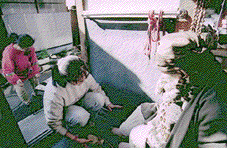 Science & Technology || Search || Back Numbers CARING FOR A GRAYING JAPAN:
 The plan should let more elderly receive care at home. (Photo: Jiji Gaho Sha, Inc.) As part of the government's response to the rapid aging of Japan's population, a range of bills aimed at establishing a system of public nursing-care services are moving toward approval in the Japanese Diet, which ended its regular session on June 18. Discussion on the nursing-care insurance bills will carry over to the extraordinary Diet session scheduled to convene in the fall. Pending passage, they are slated to take effect from April 2000.
Participation from Age 40
The monthly payments will vary slightly according to the contributor's municipality of residence and income, but the Ministry of Health and Welfare estimates that the average monthly contribution will be about 2,500 yen (22 dollars at 115 yen to the dollar) over the first three years of the program. Salaried workers, who are enrolled in Health Insurance Societies, will split the cost of the payments with their employers. The recipients of nursing-care services will be required to pay 10% of the costs incurred, with the rest to be covered by insurance premiums and public funds. The services included in the new nursing-care system will be broadly divided into two categories: those provided at patients' homes and those provided in nursing homes and other care facilities. Based on the nursing needs of the elderly care recipients, home-care services are to range from assistance with household chores to the dispatch of nurses to patients' homes, as well as day-care services--such as bathing and rehabilitation--at care facilities. According to the Ministry of Health and Welfare's program model, those needing the least care will receive visits from nurses, home help, and day-care service once or twice a week; those most in need of nursing care will be looked after every day. It will now be up to the national and local governments to boost staff levels and the number of facilities in order to provide this standard of service.
Preparing for a Gray Age
The ratio of Japan's population aged 65 or older is expected to reach 17% in 2000 and a world-high 21% in 2010; it is estimated that it will go as high as 28% in 2040. This rapid graying of society is leading to an annual increase of over 100,000 elderly people that need nursing care or assistance with their day-to-day activities, a population that has already topped 2 million. Insufficient nursing-care services are also straining the financial health of the health insurance system by causing many elderly patients to resort to long-term, medically unnecessary "social hospitalization" instead. Unless nursing services are expanded, the estimated increase in the population of elderly needing nursing care, to 2.8 million by 2000 and to 4 million by 2010, will only exacerbate this situation. These worries provided the impetus for the decision to separate nursing services from medical care and introduce a separate social insurance scheme for the former. The Health and Welfare Ministry estimates that the plan will cost 4.2 trillion yen (36.5 billion dollars) in fiscal 2000, its first year of operation. But the burden on the health insurance system should be lessened by about 1.2 trillion yen (10.4 billion dollars) as socially hospitalized patients' coverage is switched to nursing-care insurance.
Northern European Model
The municipally operated Scandinavian schemes, on the other hand, draw on public funds to provide nursing care for the needy elderly. Medical and welfare services are unified and many care facilities offer 24-hour service. The Japanese nursing insurance scheme is a melange of these systems, featuring some of the strong points of each of them. But its introduction is not expected to be completely smooth. At present, Germany is the only nation with a nursing insurance scheme in place, and that program is still young. A period of trial and error is therefore expected to continue for some time. The nursing-care insurance system is scheduled for review five years after its implementation in fiscal 2000.
 Edited by Japan Echo Inc. based on domestic Japanese news sources. Articles presented here are offered for reference purposes and do not necessarily represent the policy or views of the Japanese Government.
Edited by Japan Echo Inc. based on domestic Japanese news sources. Articles presented here are offered for reference purposes and do not necessarily represent the policy or views of the Japanese Government.
|
